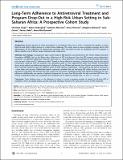Long-Term Adherence to Antiretroviral Treatment and Program Drop-out in a High-Risk Urban Setting in Sub-Saharan Africa: A Prospective Cohort Study
View/
Publication Date
10/25/2010Type
Article, Journalviews
downloads
Metadata
Show full item recordCitation
n: Unge C, So¨derga˚rd B, Marrone G, Thorson A, Lukhwaro A, et al. (2010) Long-Term Adherence to Antiretroviral Treatment and Program Drop-Out in a High-Risk Urban Setting in Sub-Saharan Africa: A Prospective Cohort Study. PLoS ONE 5(10): e13613. doi:10.1371/journal.pone.0013613
Abstract/
Background: Seventy percent of urban populations in sub-Saharan Africa live in slums. Sustaining HIV patients in these high-risk and highly mobile settings is a major future challenge. This study seeks to assess program retention and to find determinants for low adherence to antiretroviral treatment (ART) and drop-out from an established HIV/ART program in Kibera, Nairobi, one of Africa’s largest informal urban settlements. Methods and Findings: A prospective open cohort study of 800 patients was performed at the African Medical Research Foundation (AMREF) clinic in the Kibera slum. Adherence to ART and drop-out from the ART program were independent outcomes. Two different adherence measures were used: (1) ‘‘dose adherence’’ (the proportion of a prescribed dose taken over the past 4 days) and (2) ‘‘adherence index’’ (based on three adherence questions covering dosing, timing and special instructions). Drop-out from the program was calculated based on clinic appointment dates and number of prescribed doses, and a patient was defined as being lost to follow-up if over 90 days had expired since the last prescribed dose. More than one third of patients were non-adherent when all three aspects of adherence – dosing, timing and special instructions – were taken into account. Multivariate logistic regression revealed that not disclosing HIV status, having a low level of education, living below the poverty limit (US$ 2/day) and not having a treatment buddy were significant predictors for nonadherence. Additionally, one quarter of patients dropped out for more than 90 days after the last prescribed ART dose. Not having a treatment buddy was associated with increased risk for drop-out (hazard ratio 1.4, 95% CI = 1.0–1.9). Conclusion: These findings point to the dilemma of trying to sustain a growing number of people on life-long ART in conditions where prevailing stigma, poverty and food shortages threatens the long-term success of HIV treatment.
Further Details
: 2010 Unge et al. This is an open-access article distributed under the terms of the Creative Commons Attribution License, which permits unrestricted use, distribution, and reproduction in any medium, provided the original author and source are credited
Publisher
PLoS ONECollections
- General - GEN [367]

